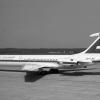Network Aviation Australia F100 at Nifty on Oct 19th 2012, hard landing
Australia's Transportation Safety Board (ATSB) released their final report concluding the probable causes of the accident were:
Contributing factors
- On approach to land at about 80 ft above ground level, the aircraft’s flight path almost certainly coincided with the strong outflow of a dry microburst, resulting in a performance-decreasing windshear that led to a rapid drop in airspeed, high sink rate, undershoot, and a hard landing.
Other factors that increased risk
- The aircraft was not fully configured for an approach in known or suspected windshear conditions, reducing the capability of the aircraft to recover from the high sink rate associated with a microburst event.
Other findings
- The aircraft was equipped with a reactive windshear warning system, but on this occasion the aircraft was below 100 ft when affected by the microburst, such that there was insufficient time for the system to generate a warning.
The ATSB reported the aircraft was positioning for a final approach to Nifty's runway 12. The captain (ATPL, 11,000 hours total, 1,250 hours on type) had briefed for a landing with full flaps and a Vapp of 128 KIAS. During the descent towards Nifty the crew was cleared to deviate around weather indicated on the aircraft weather radar. The crew contacted Nifty ground staff for an updated weather report and was told, that the wind was swirling but currently northeasterly at 5 knots, the crew told ground staff about the presence of thunderstorms in the vicinity of the aerodrome. About 5nm before touch down while turning onto final for a straight in approach the crew received a windshear caution. The crew extended full flaps, increased their Vapp by 5 knots to 133 KIAS and extended the speedbrakes to stabilize the approach and to increase engine thrust permitting a faster engine response in case of a wind shear.
The aircraft descended through 1000 feet AGL with all approach parameters within limits (stabilized approach), while descending through 500 feet AGL the first officer (ATPL, 11,400 hours total, 200 hours on type) called "stabilized approach" as required by standard operating procedures, at that point the aircraft was maintaining 133 KIAS and 800 fpm rate of descent.
Descending through 350 feet the first officer advised the wind came from 140 degrees at 12 knots as indicated by the primary flight display, the rate of descent was 750 fpm. At 300 feet the commander therefore asked the first officer to reduce their Vapp to 128 KIAS again.
Just after selecting 128 KIAS the first officer commented "there's a bit of shear coming", then added they were on speed at 900 fpm. The aircraft descended through 150 feet AGL at 128 KIAS.
At 130 feet AGL the speed abruptly changed to 124 KIAS, the first officer called "speed". The commander increaed the thrust and the speed quickly recovered. The speed brakes automatically retracted in response to the high thrust setting.
While descending from 80 to 30 feet AGL the speed changed from 133 to 110 KIAS over three seconds, the rate of descent increased to 1000 fpm, and the wind changed to 32 knots tail wind. At 15 feet AGL the EGPWS called "Sink Rate", another call "Sink Rate" occurred at 0 feet AGL. As result the aircraft touched down just past the threshold marker about 300 meters ahead of the normal touch down point at 1000 fpm rate of descent and +4.23G vertical acceleration and bounced settling on the runway 450 meters further down the runway. The commander applied normal braking and full reverse thrust stopping the aircraft well ahead of the runway end. After discussing the structural integrity of the aircraft the crew taxied the aircraft to the apron.
An aural windshear alert was not recorded.
There were no injuries to the occupants of the aircraft, the aircraft however received substantial damage including wrinkling of skin panels both forward and aft of the aircraft's center section and deformation of several structural beams as result of the hard touchdown. The main landing gear, inboard landing gear doors and skin panels on the belly fairing received compression damage.
Following onsite repairs the aircraft was ferried to Singapore where the repairs were completed by an agent of the aircraft manufacturer.
The ATSB analysed that given the weather scenario as evident by satellite images and the observation of convective activity and isolated thunderstorm cells around the aerodrome, "significantly, the meteorological conditions were conducive to the formation of dry microbursts. It is almost certain that the aircraft’s flight path on short final coincided with the strong outflow of a dry microburst in such a way as to create performance-decreasing windshear. This led to the rapid drop in airspeed, high sink rate, undershoot and hard landing."
The ATSB stated during analysis of warning systems: "On this occasion, the windsock was influenced by the windshear after the aircraft had been affected and was therefore not a useful warning of the impending shear. The same limitation applied to the equipment monitored by the ground personnel."
With respect to the aircraft windshear system the ATSB analysed: "The aircraft’s windshear warning system was reactive, and able to identify windshear only after it had affected the performance of the aircraft. Although the system was probably serviceable, there was insufficient time for the system to register the effect on the aircraft and generate an effective warning. Predictive windshear alerting systems are available, but in these circumstances would not necessarily have provided an effective alert."
The ATSB further stated, that the crew had already detected and responded to the decreasing aircraft performance when the GPWS came up with the first sink rate warnings.
The ATBS further analysed that the weather radar of the aircraft was not able to detect dry microbursts.
The ATSB analysed that with hindsight it might have been more prudent to configure the aircraft to flaps 25 and add 10-20 knots to Vapp and stated further: "Had the aircraft been fitted with a predictive windshear alerting system, that system may not have generated an alert in sufficient time for the crew to have initiated a go-around."
The ATSB concluded analysis: "The effectiveness of the operator’s guidelines relied on crew judgement of the potential for windshear, but the ability of crews to anticipate windshear was limited to knowledge of typical behaviour of thunderstorms and visual cues such as windsock indications and blowing dust. While crew judgement supported by onboard reactive alerting systems is generally effective, it does not provide a high level of assurance that this type of event will not occur again."
Belly Damage (Photo: ATSB):
Skin Panel Damage (Photo: ATSB):
http://avherald.com/h?article=457e0a83/0000














Komentarze